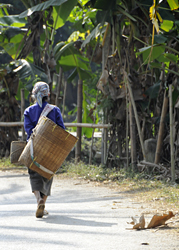

Renee Bowers
Renee Bowers is a buyer for Ten Thousand Villages, the largest fair trade retailer in the United States. In this role, she builds long–term, sustainable relationships with artisans who lack employment opportunities and market access. She works primarily in India, where she partners with artisans to develop and produce hand–woven and hand–printed textiles within the framework of fair trade. She also has diverse experience within the international crafts sector. As a senior research fellow with the American Institute of Indian Studies, Bowers worked closely with traditional puppeteers and puppet carvers in Karnataka, South India. She also has lived and worked in Latin America, where she conducted workshops on the use of low–cost, locally available arts materials. She is currently a student in the University of Delaware's Socially Responsible and Sustainable Apparel Business graduate certificate program.
Over the past decade there has been an increased emphasis on labor standards and human rights within the textile and apparel industry. This has led to a great deal of self examination within both the fair trade and mainstream industries, with extensive discussion of the ways that companies can maintain ethical sourcing standards in overseas production. Because fair trade buyers have most often approached their work from a development perspective, with the goal of increasing producers’ quality of life as well as meeting consumer demands (Littrell and Dickson, 2010), fair trade buyers must take a different approach to purchasing decisions than their mainstream counterparts.
Fair trade buyers approach each purchasing decision by asking not only the traditional question, “Is this the right product at the right time?” but also by evaluating whether it is sourced in a way that provides long–term, sustainable income for producers. It is this decision–making process, far more than just wages or even overall labor standards, which truly sets the fair trade model apart. Examining the factors that inform this line of questioning, as well as the practical steps that fair trade buyers take in order to meet the needs of producers, can serve as a model for buyers across industries who wish to have a truly successful ethical sourcing strategy.

Researchers have found, and suppliers have confirmed, that workers suffer when purchasing practices do not support human rights goals. While suppliers are often given a mandate to meet high ethical standards in buyers’ codes of conduct, they also must deal with the competing and often contradictory demands of those same buyers. Thus, suppliers are being pulled in two directions–the demands of ethical sourcing on one hand and the demands of shareholders and the marketplace on the other.
Hurst, Murdoch and Gould (2005) cite tight lead times, late sample approval, and last–minute changes as some of the key external drivers leading to excessive worker overtime, worker turnover, low productivity, and sub–par wages. In the Ethical Trading Initiative’s 2006 Impact Assessment, “suppliers complained that it was sometimes hard to improve labour practices, or comply with certain aspects of codes, given the purchasing practices of most buyers” (p 33). The fair trade model, in contrast, is specifically designed to support workers and help create positive buyer/supplier relationships by expanding the notion of fair trade beyond a simple concern for wages.
One of the primary goals of fair trade, as reflected in the mission statements of the Fair Trade Federation, the World Fair Trade Organization, and others, is to create economic opportunities for producers who lack market access. One of the principal ways of achieving this goal is to maintain long–term purchasing relationships that provide predictable, sustainable income to vulnerable producers in an otherwise fluctuating marketplace. This allows producers to better predict their own yearly production and avoid the unnecessary financial risks that come from “boom or bust” order cycles. It also gives producers the security of knowing that business will not be automatically yanked away at the first sign of an obstacle or a change in consumer demand.
On a practical level, this means that buyers strive to maintain purchasing budgets from year to year within a certain range, increasing budgets when possible. This may seem simple enough. However, in practice this represents a radical way of doing business. In order to maintain effective, long–term purchasing relationships with vulnerable producer groups, buyers sometimes must choose products that may not sell over products that will. In other words, risky products from vulnerable producers may sometimes need to take priority over more marketable products from producers who already have a stable income.
A second radical aspect of the fair trade purchasing process is the idea that product success should not be judged simply by raw sales data. This is in stark contrast to most mainstream retail organizations, in which a buyer’s job performance and pay is judged based on sales margin and profits. This traditional model provides a powerful disincentive for buyers to consider anything other than trend and price in making their decisions, ultimately leading to inconsistencies and abuses on the factory floor. Unfortunately, even in cases where basic compensation structures can be changed, this conventional mindset is difficult to eradicate; Zadek (2004) describes a situation at Nike in which a widespread change to corporate culture was necessary in order to integrate this thinking into their buyers’ practices.
Within fair trade, however, this shift is made easier out of necessity rather than design; because most fair trade organizations are relatively small, the buyers, designers, sourcing team, and production team are often one and the same. In practice, this makes it easier for buyers to understand the limitations that exist at the producer level, react to them, and judge product success in a more nuanced way that keeps long–term development goals, rather than short–term sales numbers, in the forefront of their decision–making process.

One of the more innovative ways that some fair trade organizations have maintained core principles is to create a dual ordering cycle that allows buyers to take a risk with new items while still maintaining long-term, steady purchases. Ten Thousand Villages, for example, commits to selling each individual item for as long as it continues to meet a minimum sales margin; as a result, some products remain in stores for years (with the longest–selling item having been introduced in 1979).
For most mainstream businesses, this is unheard of. The pressure, whether real or perceived, to meet consumers’ demands for new products every few weeks or months causes buyers to place new orders at a fast pace. This “fast fashion” approach can be highly problematic for workers; Oxfam Hong Kong (2004) reports that “workers … complain that frequent changes in styles have led to a loss of earnings, as they need time and practice to sew each particular item, and as they are paid per piece, each adjustment means less earnings” (p 14). By maintaining a core group of products over a long period of time, fair trade organizations can help mitigate the effects of frequent style changes while still encouraging producers to invest in the development of new samples.
A further implication of maintaining long–term purchases is that fair trade buyers must look at fashion trends as only part of the equation of what defines a successful product. It takes a long time for small–scale, emerging producer groups to create products by hand, and as a result fair trade buyers often work to develop designs a full 9 to 12 months in advance of a product’s introduction in stores.
Again, this is markedly different from what happens in mainstream industry, where lead times are becoming ever shorter; Oxfam Hong Kong (2004) reports that average delivery times decreased from three months in 2001 to only two months in 2003, while Oxfam International (2004) states that production times have decreased 30 percent in five years. Shortened lead times create a high–pressure, high–stress environment on factory floors, and workers bear the brunt of this time crunch. The fair trade approach, therefore, is to identify long–term trends that have staying power and to interpret trend information in a way that will keep products current without changing moment by moment.
It is important to note that the fair trade purchasing practices outlined above are not necessarily laid out as official policy. Rather, they represent a decision–making process that is deeply embedded within the fair trade model and fully integrated into buyers’ daily thinking. As the fair trade movement grows, there will inevitably be buyers who interpret their roles differently from what I have outlined above.
However, these core purchasing practices can be used as a guide for creating sustainable supplier relationships that take into account the needs of workers as well as the demands of the marketplace. While the public perception of fair trade is often defined by the wages that producers receive, in practice fair trade is a complex relationship between buyers and producers in which both parties take responsibility for developing an ethical supply chain that supports workers.
References
1. Ethical Trading Initiative. (2007). Purchasing practices: case studies to address impacts of
purchasing practices on working conditions (Report from ETI members meeting, 29 November 2007). London: Ethical Trading Initiative. Retrieved November 8, 2010, from http://www.ethicaltrade.org/resources/key-eti-resources/purchasing-practices-case-studies.
2. Hurst, R., Murdoch, H., & Gould, D. (2005). Changing over time: Tackling supply chain
labour issues through business practice. Available from the The Impactt Overtime Project at http://www.impacttlimited.com/resources/changing-overtime-tackling-supply-chain-labour-issues-through-business-practice.
3. Littrell, M. A., & Dickson, M. A. (2010). Artisans and fair trade: crafting development. Sterling, VA: Kumarian Press.
4. Oxfam Hong Kong. (2004). Turning the garment industry inside out: purchasing practices and
workers’ lives (Oxfam Hong Kong Briefing Paper, April 2004). Hong Kong: Oxfam.
5. Oxfam International. (2003.) Trading away our rights: women working in global supply chains.
Oxford: Oxfam International. Retrieved November 10, 2010, from http://www.maketradefair.com/en/assets/english/taor.pdf.
6. Zadek, S. (2004, December). The path to corporate responsibility. Harvard Business Review,
125–132.